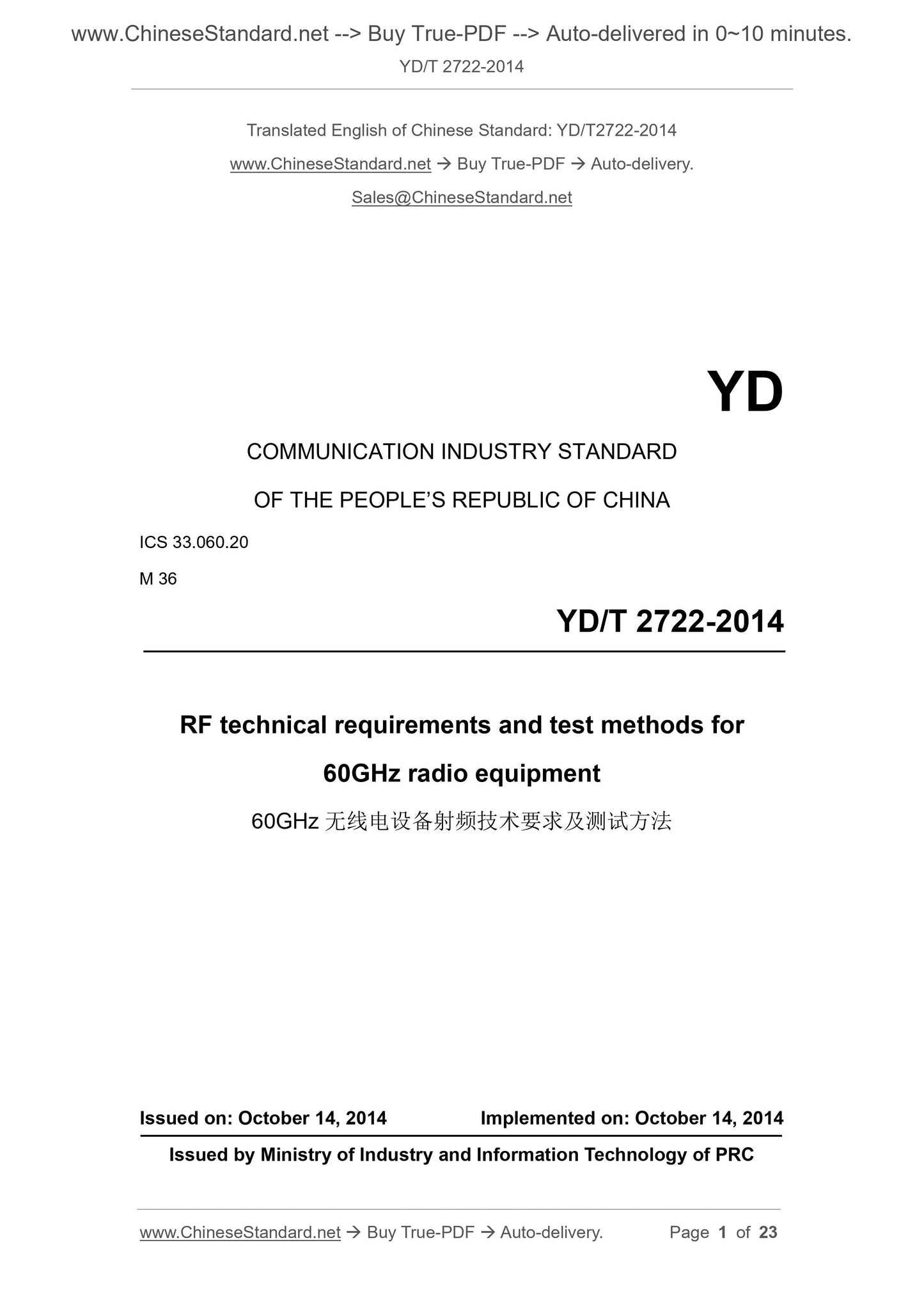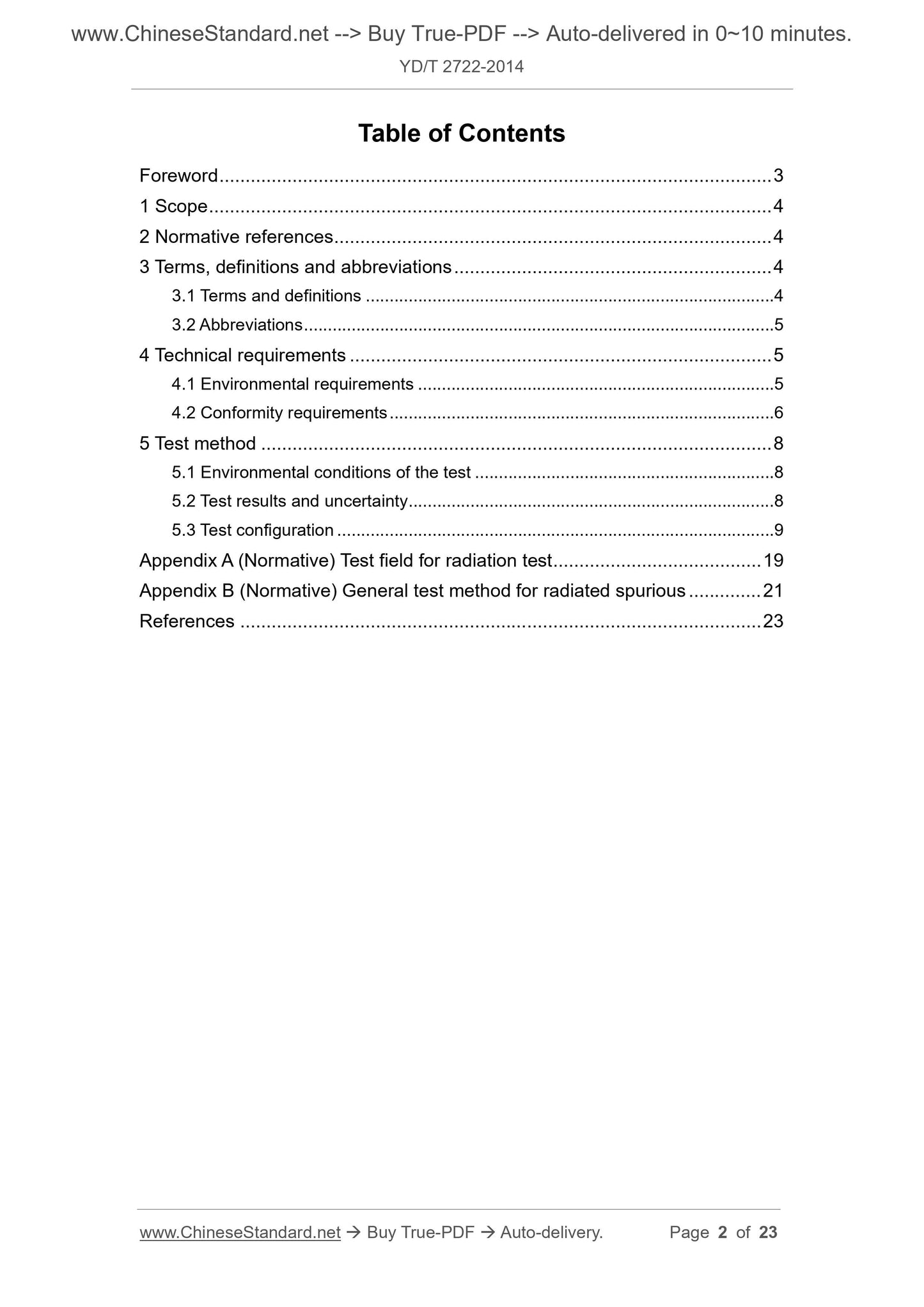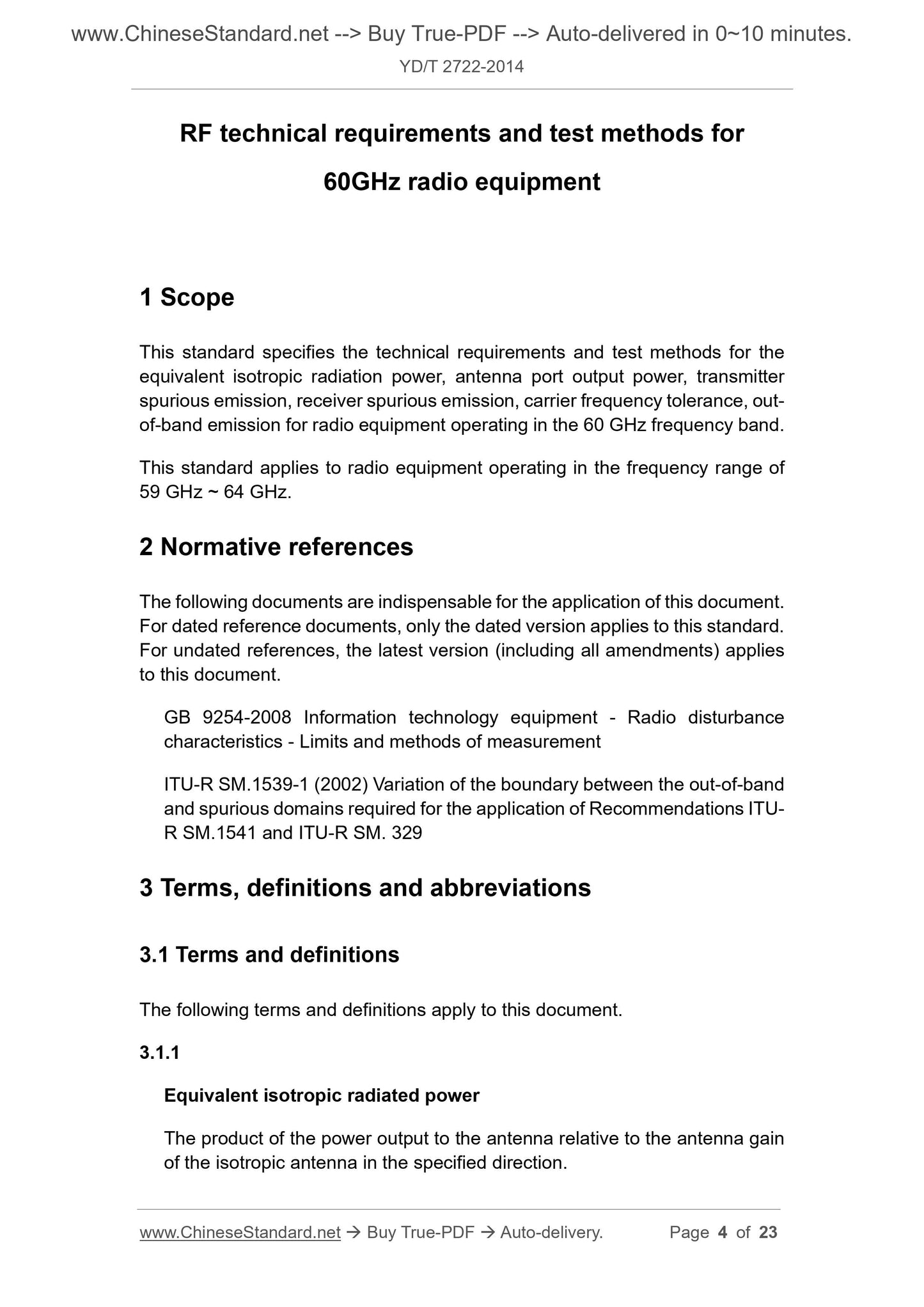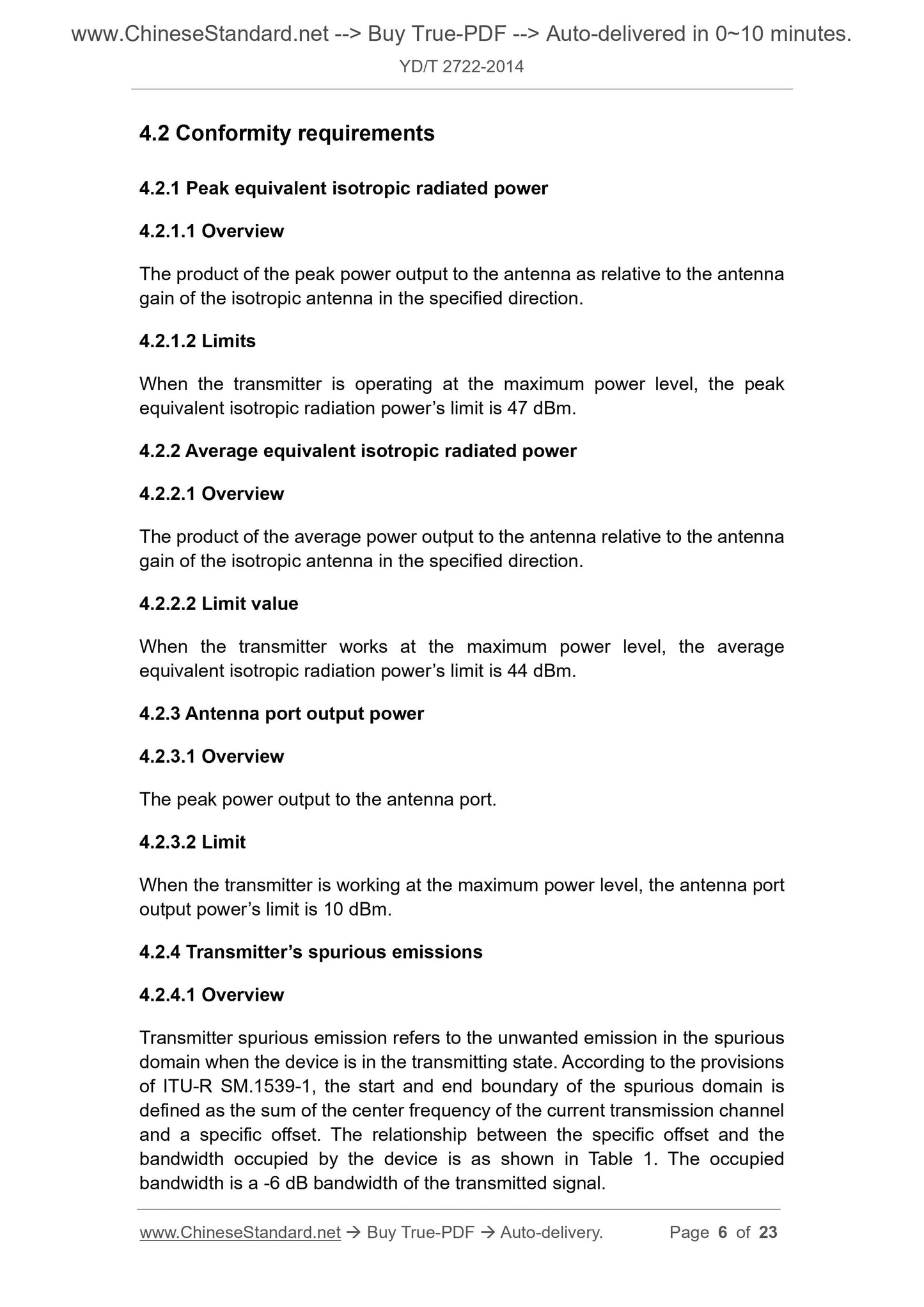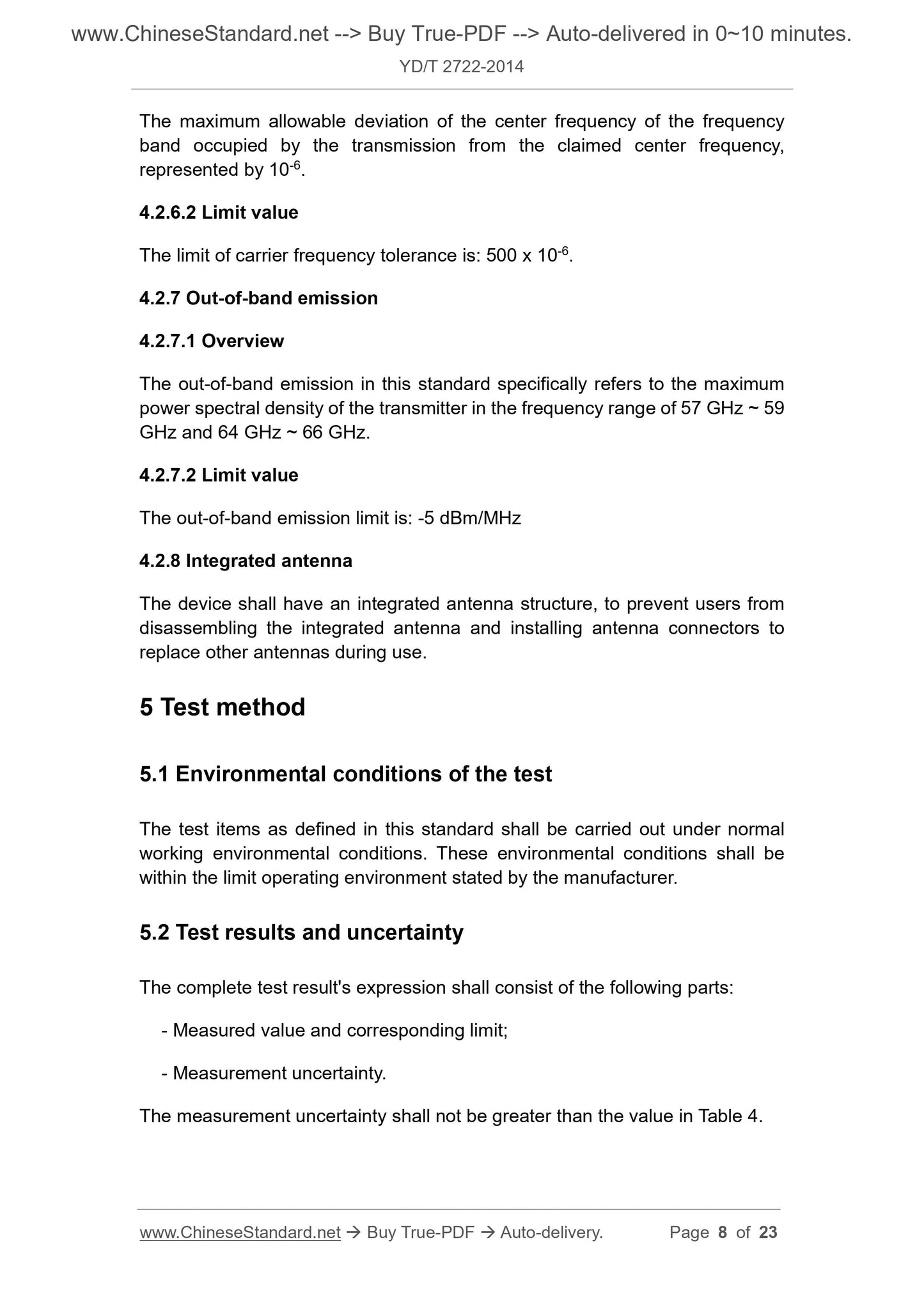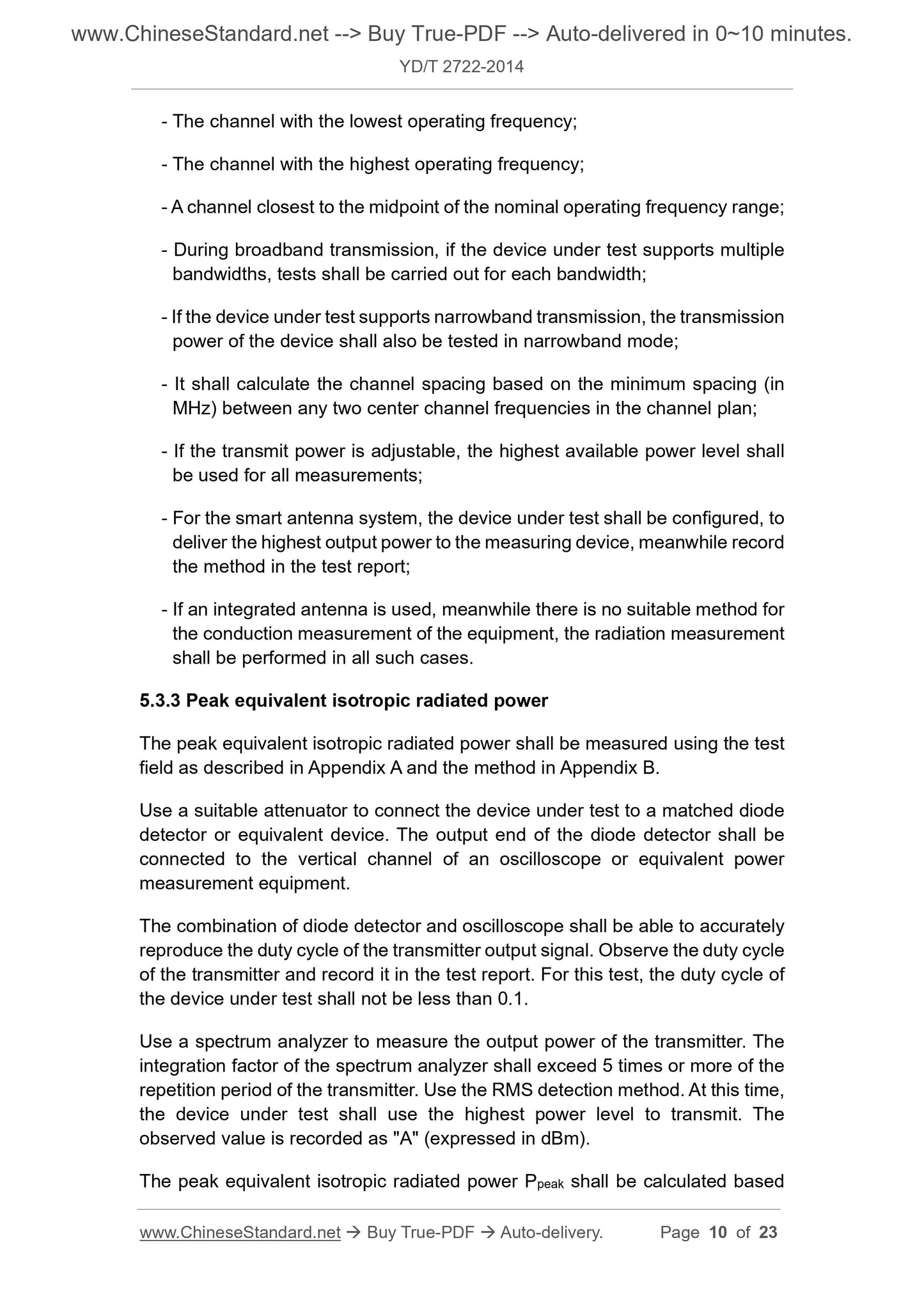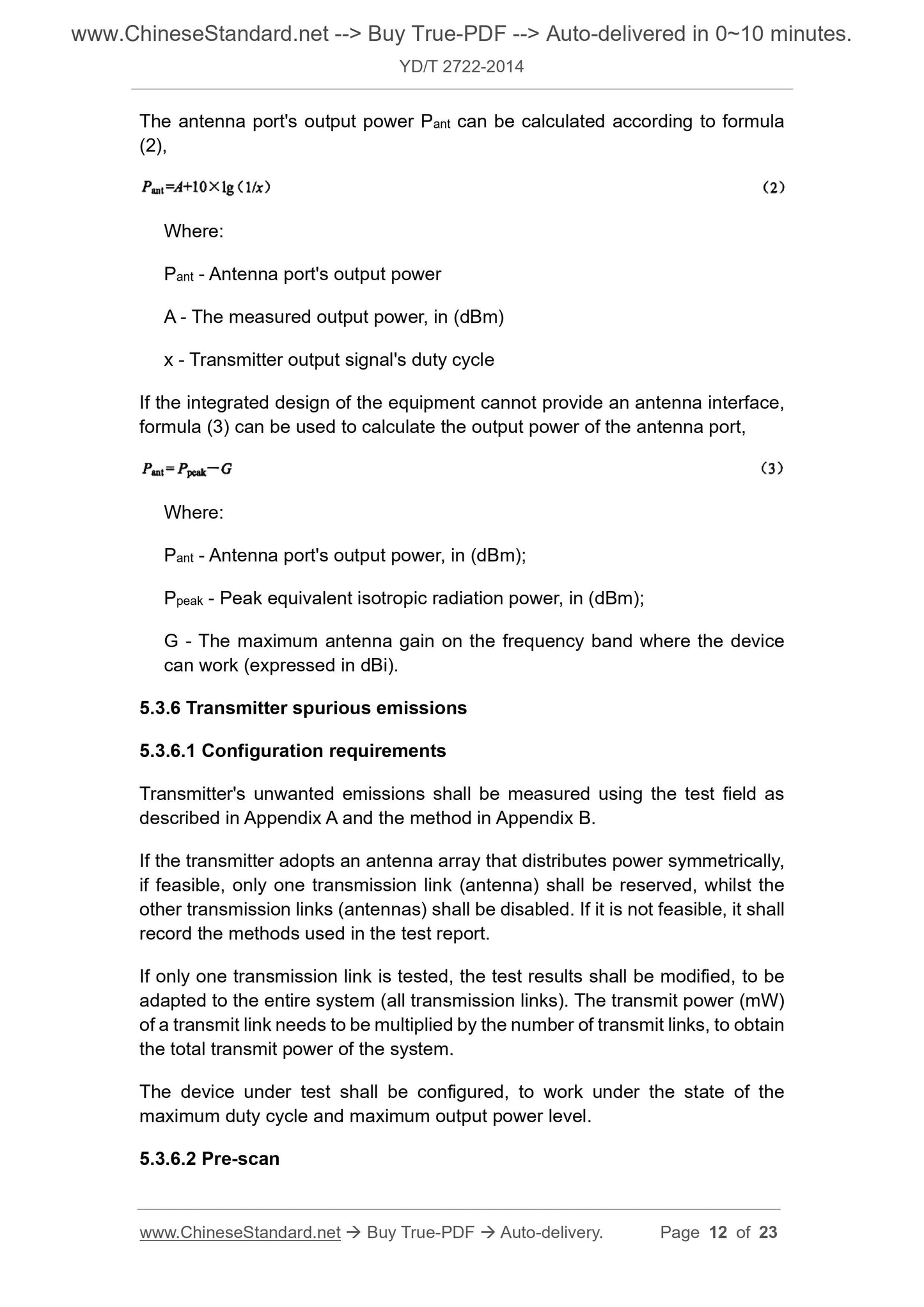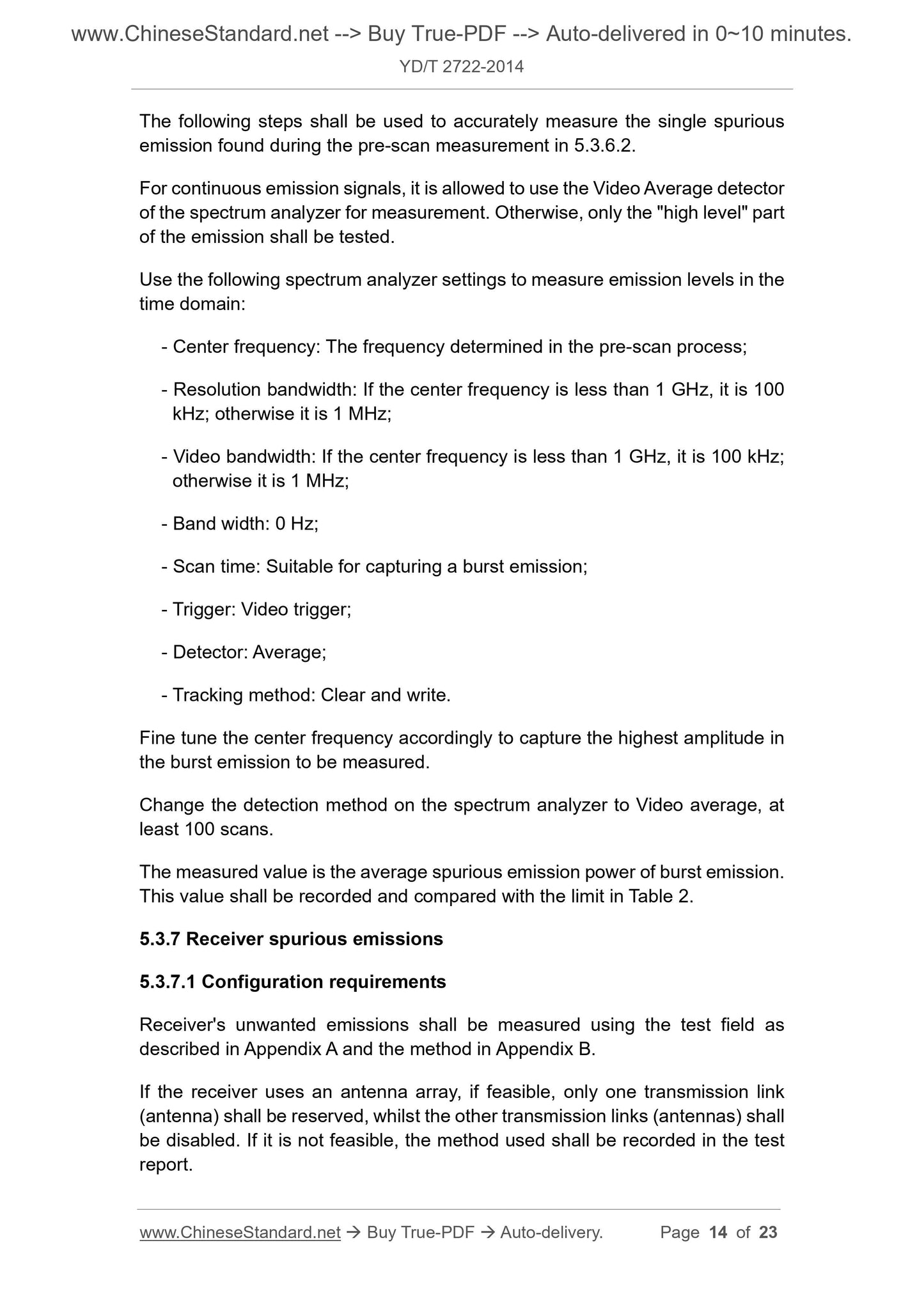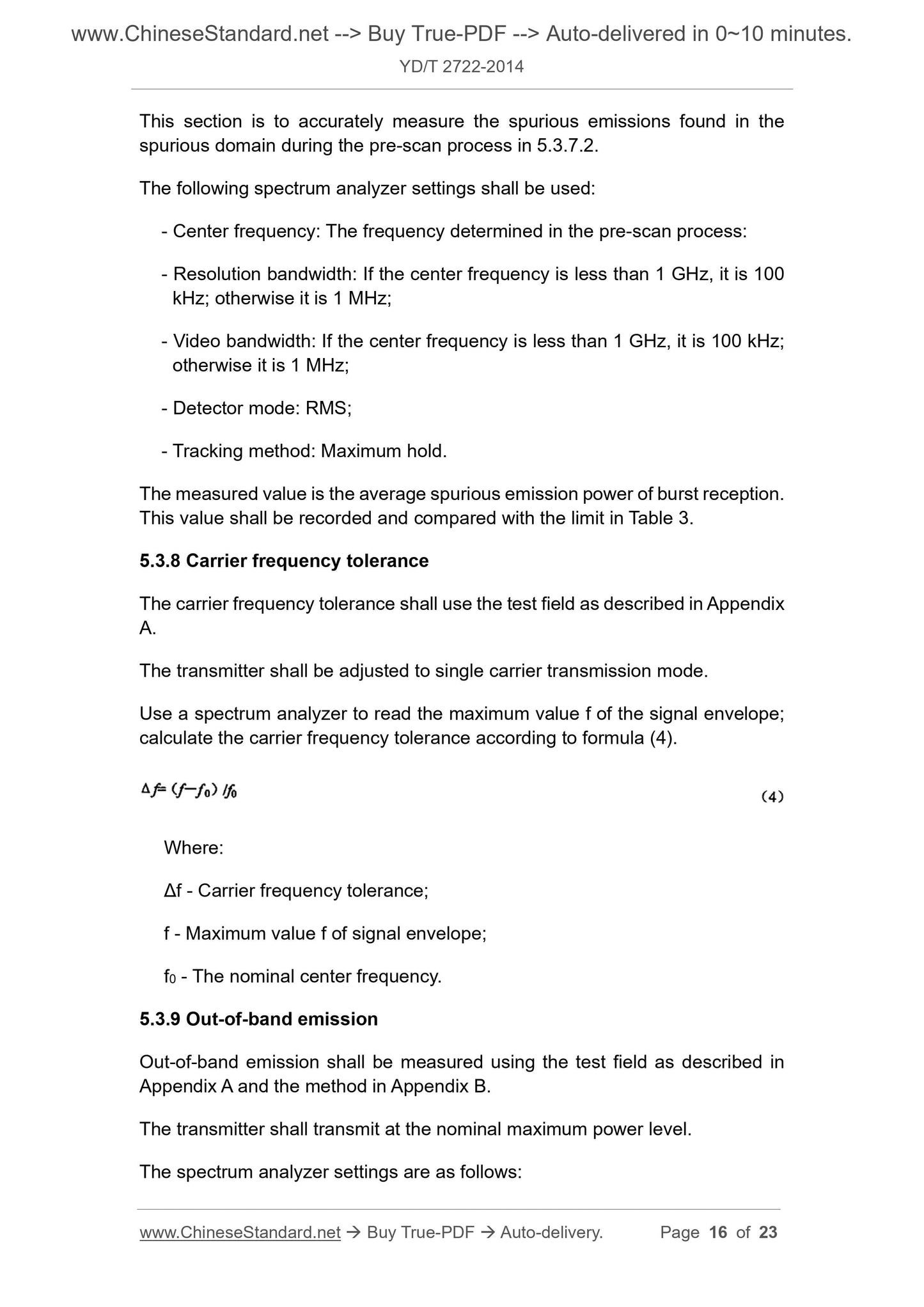1
/
of
9
PayPal, credit cards. Download editable-PDF and invoice in 1 second!
YD/T 2722-2014 English PDF (YDT2722-2014)
YD/T 2722-2014 English PDF (YDT2722-2014)
Regular price
$370.00 USD
Regular price
Sale price
$370.00 USD
Unit price
/
per
Shipping calculated at checkout.
Couldn't load pickup availability
Delivery: 3 seconds. Download true-PDF + Invoice.
Get QUOTATION in 1-minute: Click YD/T 2722-2014
Historical versions: YD/T 2722-2014
Preview True-PDF (Reload/Scroll if blank)
YD/T 2722-2014: RF technical requirements and test methods for 60GHz radio equipment
YD/T 2722-2014
YD
COMMUNICATION INDUSTRY STANDARD
OF THE PEOPLE’S REPUBLIC OF CHINA
ICS 33.060.20
M 36
RF technical requirements and test methods for
60GHz radio equipment
ISSUED ON: OCTOBER 14, 2014
IMPLEMENTED ON: OCTOBER 14, 2014
Issued by Ministry of Industry and Information Technology of PRC
Table of Contents
Foreword ... 3
1 Scope ... 4
2 Normative references ... 4
3 Terms, definitions and abbreviations ... 4
3.1 Terms and definitions ... 4
3.2 Abbreviations ... 5
4 Technical requirements ... 5
4.1 Environmental requirements ... 5
4.2 Conformity requirements ... 6
5 Test method ... 8
5.1 Environmental conditions of the test ... 8
5.2 Test results and uncertainty ... 8
5.3 Test configuration ... 9
Appendix A (Normative) Test field for radiation test ... 19
Appendix B (Normative) General test method for radiated spurious ... 21
References ... 23
RF technical requirements and test methods for
60GHz radio equipment
1 Scope
This standard specifies the technical requirements and test methods for the
equivalent isotropic radiation power, antenna port output power, transmitter
spurious emission, receiver spurious emission, carrier frequency tolerance, out-
of-band emission for radio equipment operating in the 60 GHz frequency band.
This standard applies to radio equipment operating in the frequency range of
59 GHz ~ 64 GHz.
2 Normative references
The following documents are indispensable for the application of this document.
For dated reference documents, only the dated version applies to this standard.
For undated references, the latest version (including all amendments) applies
to this document.
GB 9254-2008 Information technology equipment - Radio disturbance
characteristics - Limits and methods of measurement
ITU-R SM.1539-1 (2002) Variation of the boundary between the out-of-band
and spurious domains required for the application of Recommendations ITU-
R SM.1541 and ITU-R SM. 329
3 Terms, definitions and abbreviations
3.1 Terms and definitions
The following terms and definitions apply to this document.
3.1.1
Equivalent isotropic radiated power
The product of the power output to the antenna relative to the antenna gain
of the isotropic antenna in the specified direction.
4.2 Conformity requirements
4.2.1 Peak equivalent isotropic radiated power
4.2.1.1 Overview
The product of the peak power output to the antenna as relative to the antenna
gain of the isotropic antenna in the specified direction.
4.2.1.2 Limits
When the transmitter is operating at the maximum power level, the peak
equivalent isotropic radiation power’s limit is 47 dBm.
4.2.2 Average equivalent isotropic radiated power
4.2.2.1 Overview
The product of the average power output to the antenna relative to the antenna
gain of the isotropic antenna in the specified direction.
4.2.2.2 Limit value
When the transmitter works at the maximum power level, the average
equivalent isotropic radiation power’s limit is 44 dBm.
4.2.3 Antenna port output power
4.2.3.1 Overview
The peak power output to the antenna port.
4.2.3.2 Limit
When the transmitter is working at the maximum power level, the antenna port
output power’s limit is 10 dBm.
4.2.4 Transmitter’s spurious emissions
4.2.4.1 Overview
Transmitter spurious emission refers to the unwanted emission in the spurious
domain when the device is in the transmitting state. According to the provisions
of ITU-R SM.1539-1, the start and end boundary of the spurious domain is
defined as the sum of the center frequency of the current transmission channel
and a specific offset. The relationship between the specific offset and the
bandwidth occupied by the device is as shown in Table 1. The occupied
bandwidth is a -6 dB bandwidth of the transmitted signal.
The maximum allowable deviation of the center frequency of the frequency
band occupied by the transmission from the claimed center frequency,
represented by 10-6.
4.2.6.2 Limit value
The limit of carrier frequency tolerance is: 500 x 10-6.
4.2.7 Out-of-band emission
4.2.7.1 Overview
The out-of-band emission in this standard specifically refers to the maximum
power spectral density of the transmitter in the frequency range of 57 GHz ~ 59
GHz and 64 GHz ~ 66 GHz.
4.2.7.2 Limit value
The out-of-band emission limit is: -5 dBm/MHz
4.2.8 Integrated antenna
The device shall have an integrated antenna structure, to prevent users from
disassembling the integrated antenna and installing antenna connectors to
replace other antennas during use.
5 Test method
5.1 Environmental conditions of the test
The test items as defined in this standard shall be carried out under normal
working environmental conditions. These environmental conditions shall be
within the limit operating environment stated by the manufacturer.
5.2 Test results and uncertainty
The complete test result's expression shall consist of the following parts:
- Measured value and corresponding limit;
- Measurement uncertainty.
The measurement uncertainty shall not be greater than the value in Table 4.
- The channel with the lowest operating frequency;
- The channel with the highest operating frequency;
- A channel closest to the midpoint of the nominal operating frequency range;
- During broadband transmission, if the device under test supports multiple
bandwidths, tests shall be carried out for each bandwidth;
- If the device under test supports narrowband transmission, the transmission
power of the device shall also be tested in narrowband mode;
- It shall calculate the channel spacing based on the minimum spacing (in
MHz) between any two center channel frequencies in the channel plan;
- If the transmit power is adjustable, the highest available power level shall
be used for all measurements;
- For the smart antenna system, the device under test shall be configured, to
deliver the highest output power to the measuring device, meanwhile record
the method in the test report;
- If an integrated antenna is used, meanwhile there is no suitable method for
the conduction measurement of the equipment, the radiation measurement
shall be performed in all such cases.
5.3.3 Peak equivalent isotropic radiated power
The peak equivalent isotropic radiated power shall be measured using the test
field as described in Appendix A and the method in Appendix B.
Use a suitable attenuator to connect the device under test to a matched diode
detector or equivalent device. The output end of the diode detector shall be
connected to the vertical channel of an oscilloscope or equivalent power
measurement equipment.
The combination of diode detector and oscilloscope shall be able to accurately
reproduce the duty cycle of the transmitter output signal. Observe the duty cycle
of the transmitter and record it in the test report. For this test, the duty cycle of
the device under test shall not be less than 0.1.
Use a spectrum analyzer to measure the output power of the transmitter. The
integration factor of the spectrum analyzer shall exceed 5 times or more of the
repetition period of the transmitter. Use the RMS detection method. At this time,
the device under test shall use the highest power level to transmit. The
observed value is recorded as "A" (expressed in dBm).
The peak equivalent isotropic radiated power Ppeak shall be calculated based
The antenna port's out...
Get QUOTATION in 1-minute: Click YD/T 2722-2014
Historical versions: YD/T 2722-2014
Preview True-PDF (Reload/Scroll if blank)
YD/T 2722-2014: RF technical requirements and test methods for 60GHz radio equipment
YD/T 2722-2014
YD
COMMUNICATION INDUSTRY STANDARD
OF THE PEOPLE’S REPUBLIC OF CHINA
ICS 33.060.20
M 36
RF technical requirements and test methods for
60GHz radio equipment
ISSUED ON: OCTOBER 14, 2014
IMPLEMENTED ON: OCTOBER 14, 2014
Issued by Ministry of Industry and Information Technology of PRC
Table of Contents
Foreword ... 3
1 Scope ... 4
2 Normative references ... 4
3 Terms, definitions and abbreviations ... 4
3.1 Terms and definitions ... 4
3.2 Abbreviations ... 5
4 Technical requirements ... 5
4.1 Environmental requirements ... 5
4.2 Conformity requirements ... 6
5 Test method ... 8
5.1 Environmental conditions of the test ... 8
5.2 Test results and uncertainty ... 8
5.3 Test configuration ... 9
Appendix A (Normative) Test field for radiation test ... 19
Appendix B (Normative) General test method for radiated spurious ... 21
References ... 23
RF technical requirements and test methods for
60GHz radio equipment
1 Scope
This standard specifies the technical requirements and test methods for the
equivalent isotropic radiation power, antenna port output power, transmitter
spurious emission, receiver spurious emission, carrier frequency tolerance, out-
of-band emission for radio equipment operating in the 60 GHz frequency band.
This standard applies to radio equipment operating in the frequency range of
59 GHz ~ 64 GHz.
2 Normative references
The following documents are indispensable for the application of this document.
For dated reference documents, only the dated version applies to this standard.
For undated references, the latest version (including all amendments) applies
to this document.
GB 9254-2008 Information technology equipment - Radio disturbance
characteristics - Limits and methods of measurement
ITU-R SM.1539-1 (2002) Variation of the boundary between the out-of-band
and spurious domains required for the application of Recommendations ITU-
R SM.1541 and ITU-R SM. 329
3 Terms, definitions and abbreviations
3.1 Terms and definitions
The following terms and definitions apply to this document.
3.1.1
Equivalent isotropic radiated power
The product of the power output to the antenna relative to the antenna gain
of the isotropic antenna in the specified direction.
4.2 Conformity requirements
4.2.1 Peak equivalent isotropic radiated power
4.2.1.1 Overview
The product of the peak power output to the antenna as relative to the antenna
gain of the isotropic antenna in the specified direction.
4.2.1.2 Limits
When the transmitter is operating at the maximum power level, the peak
equivalent isotropic radiation power’s limit is 47 dBm.
4.2.2 Average equivalent isotropic radiated power
4.2.2.1 Overview
The product of the average power output to the antenna relative to the antenna
gain of the isotropic antenna in the specified direction.
4.2.2.2 Limit value
When the transmitter works at the maximum power level, the average
equivalent isotropic radiation power’s limit is 44 dBm.
4.2.3 Antenna port output power
4.2.3.1 Overview
The peak power output to the antenna port.
4.2.3.2 Limit
When the transmitter is working at the maximum power level, the antenna port
output power’s limit is 10 dBm.
4.2.4 Transmitter’s spurious emissions
4.2.4.1 Overview
Transmitter spurious emission refers to the unwanted emission in the spurious
domain when the device is in the transmitting state. According to the provisions
of ITU-R SM.1539-1, the start and end boundary of the spurious domain is
defined as the sum of the center frequency of the current transmission channel
and a specific offset. The relationship between the specific offset and the
bandwidth occupied by the device is as shown in Table 1. The occupied
bandwidth is a -6 dB bandwidth of the transmitted signal.
The maximum allowable deviation of the center frequency of the frequency
band occupied by the transmission from the claimed center frequency,
represented by 10-6.
4.2.6.2 Limit value
The limit of carrier frequency tolerance is: 500 x 10-6.
4.2.7 Out-of-band emission
4.2.7.1 Overview
The out-of-band emission in this standard specifically refers to the maximum
power spectral density of the transmitter in the frequency range of 57 GHz ~ 59
GHz and 64 GHz ~ 66 GHz.
4.2.7.2 Limit value
The out-of-band emission limit is: -5 dBm/MHz
4.2.8 Integrated antenna
The device shall have an integrated antenna structure, to prevent users from
disassembling the integrated antenna and installing antenna connectors to
replace other antennas during use.
5 Test method
5.1 Environmental conditions of the test
The test items as defined in this standard shall be carried out under normal
working environmental conditions. These environmental conditions shall be
within the limit operating environment stated by the manufacturer.
5.2 Test results and uncertainty
The complete test result's expression shall consist of the following parts:
- Measured value and corresponding limit;
- Measurement uncertainty.
The measurement uncertainty shall not be greater than the value in Table 4.
- The channel with the lowest operating frequency;
- The channel with the highest operating frequency;
- A channel closest to the midpoint of the nominal operating frequency range;
- During broadband transmission, if the device under test supports multiple
bandwidths, tests shall be carried out for each bandwidth;
- If the device under test supports narrowband transmission, the transmission
power of the device shall also be tested in narrowband mode;
- It shall calculate the channel spacing based on the minimum spacing (in
MHz) between any two center channel frequencies in the channel plan;
- If the transmit power is adjustable, the highest available power level shall
be used for all measurements;
- For the smart antenna system, the device under test shall be configured, to
deliver the highest output power to the measuring device, meanwhile record
the method in the test report;
- If an integrated antenna is used, meanwhile there is no suitable method for
the conduction measurement of the equipment, the radiation measurement
shall be performed in all such cases.
5.3.3 Peak equivalent isotropic radiated power
The peak equivalent isotropic radiated power shall be measured using the test
field as described in Appendix A and the method in Appendix B.
Use a suitable attenuator to connect the device under test to a matched diode
detector or equivalent device. The output end of the diode detector shall be
connected to the vertical channel of an oscilloscope or equivalent power
measurement equipment.
The combination of diode detector and oscilloscope shall be able to accurately
reproduce the duty cycle of the transmitter output signal. Observe the duty cycle
of the transmitter and record it in the test report. For this test, the duty cycle of
the device under test shall not be less than 0.1.
Use a spectrum analyzer to measure the output power of the transmitter. The
integration factor of the spectrum analyzer shall exceed 5 times or more of the
repetition period of the transmitter. Use the RMS detection method. At this time,
the device under test shall use the highest power level to transmit. The
observed value is recorded as "A" (expressed in dBm).
The peak equivalent isotropic radiated power Ppeak shall be calculated based
The antenna port's out...
Share
